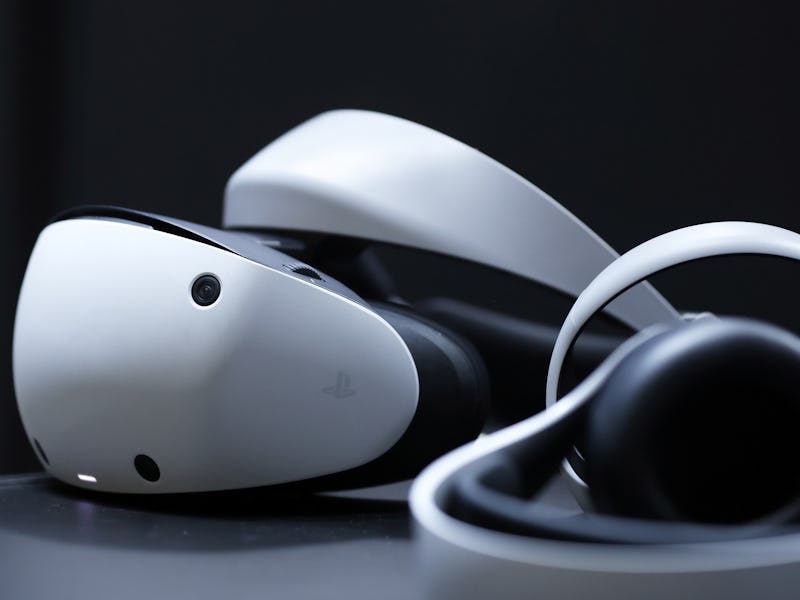
The PlayStation VR 2 launched just over a year ago, in February 2023, but a new report indicates the gaming headset may already be in trouble. Despite Sony’s hope that the PSVR 2 would usher in a new era of console VR, it may instead mark the end of a shaky experiment.
After producing 2 million headsets, Sony is halting production due to a surplus of unsold units, Bloomberg reports. Sony said the PSVR 2 sold 600,000 units in the first six weeks after its launch, but hasn’t released figures since then. Shipments of the headset to retailers have fallen every quarter since launch, according to Bloomberg.
PSVR 2’s controllers might be a selling point, but not at the headset’s price.
This probably doesn’t come as much of a surprise. Virtual reality has always been a niche part of gaming, and if you’re not looking specifically for new VR releases, it would have been easy not to hear a single word about PSVR 2 since its launch. It may be even less surprising for people who did jump on the VR train with the PS5, since it’s pretty hard to ignore the distinct lack of new titles coming to the platform.
If the slow pace of big releases wasn’t enough, unexpected developments as Sony last month definitely signaled something was wrong. In late February, Sony laid off 900 people across its internal studios, including London Studio and Firesprite, the developers behind the 2019 VR hit Blood & Truth and PSVR 2 launch title Horizon: Call of the Mountain, respectively. Without Firesprite and London Studio, PSVR 2 loses a lot of its appeal, making VR versions of existing PS5 titles like Gran Turismo 7 its biggest selling point.
That’s not to say VR itself is going anywhere. Outside of tentpole titles like Call of the Mountain, the format has plenty to offer. Games like Beat Saber, Moss, and Half-Life: Alyx are still worth playing. The question isn’t whether VR will survive, but whether it will have any place on consoles going forward. Aside from the rare PlayStation exclusive, almost every PSVR 2 game that’s worth playing is also available on other headsets, and some, like Half-Life: Alyx, aren’t on PSVR at all.
Horizon: Call of the Mountain is a great game stuck on a failing platform.
So then why would anyone choose PSVR 2 over the Meta Quest or any other headset? Well, I don’t have an answer for that, and it seems Sony never did either. PSVR 2 is a huge step up from its predecessor, but it comes with some major drawbacks. For one, it still has to be physically connected to a PS5, since the console itself actually runs the games. Every other major headset is wireless, which makes a big difference in games that require a lot of arm movement.
The fact that you need a PS5 to play it at all is also a huge drawback. The PSVR 2 is pricey at $550, on top of the $500 you already paid for the console. At $500 to $650, the Meta Quest 3 is by no means cheap, but it’s nowhere near as expensive as buying a PSVR 2 and PS5.
All of that makes the PSVR 2 an extremely tough sell when it also has significantly fewer games than other headsets. Since PSVR 2 is tied to the PlayStation’s game library, it doesn’t offer access to the much larger collection of titles available on Steam or through Meta’s own storefront. Yes, it has a handful of games that aren’t available on other platforms, but the tradeoff is being locked out of the majority of VR games that exist.
Some of the best VR games out there aren’t on PSVR 2.
Given all that, it’s no wonder the PSVR 2 isn’t selling. But as Sony’s VR headset falters, others are thriving. Meta shipped 1.3 million headsets in the last quarter of 2023 after the launch of the Meta Quest 3. In the same period, Sony shipped only 325,000 PSVR 2 boxes, and we now know that many of those are still sitting unsold. VR seems to be doing fine. It’s console integration that’s suffering.
Even Sony seems to acknowledge that. In February, the company announced it’s testing PC compatibility for the PSVR 2. That means that Sony’s headset could soon be paired with a PC to access the much larger library of games available there. That could be the saving grace PSVR 2 needs, but it also makes it a very different piece of hardware. A headset compatible with PC and PS5 is fundamentally different from the initial selling point of the PSVR 2, and seems to suggest Sony is giving up on its original idea for the headset.
It can’t be ignored that Sony is also the only console maker still in the VR game. Xbox has never had a VR headset of its own, while the closest Nintendo ever came was Labo (marketed from the beginning as a quirky toy using the Switch, rather than a full-blown VR platform). Now it seems Nintendo may have gotten it right. There may be space for funky VR experiments like Labo, but the full promise of VR isn’t going to be fulfilled by staying tethered to consoles.